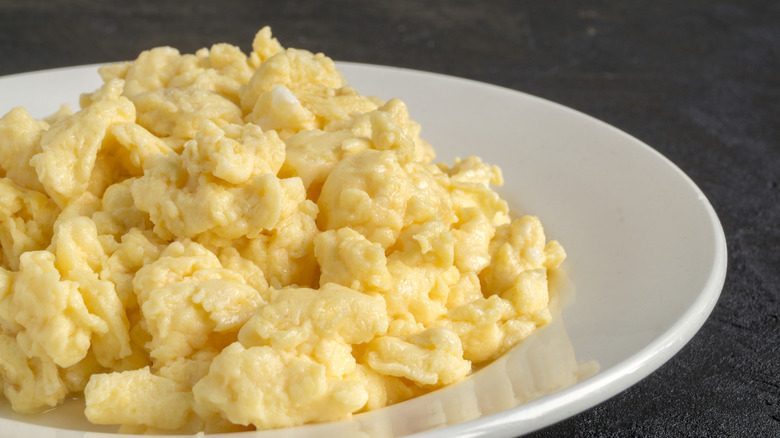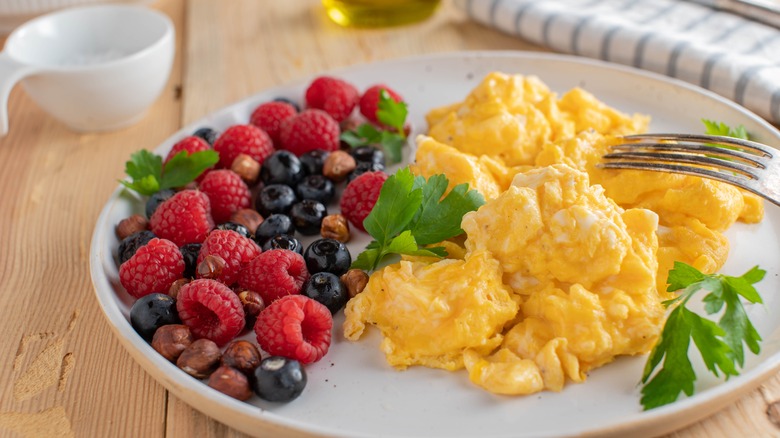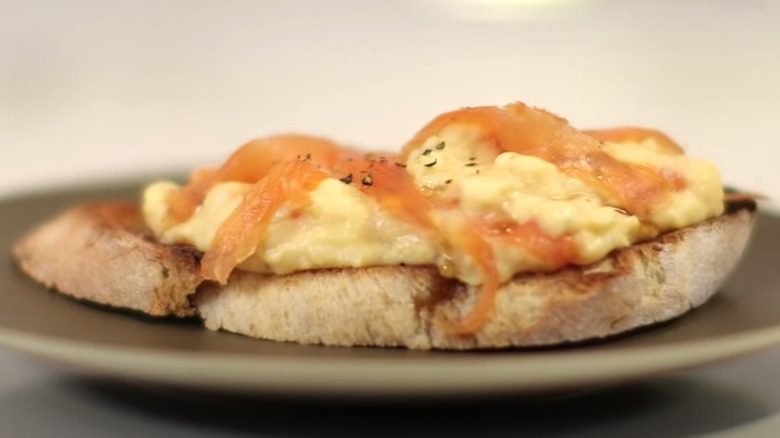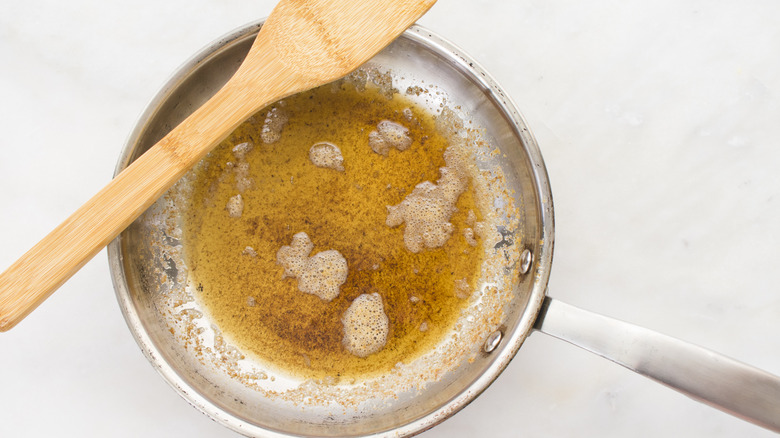The Rich Ingredient Some Top Professional Chefs Add To Scrambled Eggs
Scrambled eggs are a pretty basic dish. If you can crack an egg and can turn a burner on, you've got the skills necessary to make any scrambled egg dish you choose. But, similar to other "basic" breakfast staples, such as toast and cereal, just because scrambled eggs are easy to make doesn't mean they can't benefit from a few extra ingredients.
If you're a fan of scrambled eggs that remind you of custard, you could add butter and cream to give the eggs a very creamy, almost spreadable texture. If you want something that's more along the lines of a fried egg, combining a runny yolk with fluffy and smooth curds, you could try "frambled" eggs. Twisted Food describes this as an egg that only has the white scrambled, while the yolk itself remains intact. If you want scrambled eggs that are more for brunch than an early morning breakfast, Food Network suggests adding ricotta cheese and broccolini (a sort of "baby broccoli") to make a savory, colorful, and cheesy side dish for toasted crusty bread.
Put simply, scrambled eggs can adapt to pretty much any meat, cheese, or vegetable you could add to them. Marcus Samuelsson, known for being the head chef of Harlem's Red Rooster restaurant, has a take on scrambled eggs that includes very rich — but very simple — ingredients.
Samuelsson makes scrambled egg sandwiches
Marcus Samuelsson's scrambled egg dish isn't anything like "deconstructed scrambled eggs" or "scrambled eggs, reimagined using faux eggs." Instead, his dish is very simple: a sandwich made with biscuits and scrambled eggs (via Food & Wine). While that may sound anticlimactic, it's what's in the eggs and biscuit that makes it surprisingly decadent.
According to the recipe, the biscuits are made using beurre noisette (aka brown butter), which adds a richer, deeper, and somewhat nuttier taste to the biscuits than your average buttermilk mix would give. The scrambled eggs are prepared using standard eggs but include a sprinkling of cheddar cheese. They're scrambled in a skillet of butter and drippings from a slice of country ham. The recipe also includes "tomato jam," which The New York Times Cooking describes as a simple cross between tomato sauce and jelly, boasting a savory yet subtly sweet flavor thanks to the addition of sugar, spices, and Roma tomatoes.
By combining all of these simple, common ingredients, Samuelsson creates a breakfast sandwich that's salty, savory, and sweet, with a variety of different textures.
Heston Blementhal makes scrambled eggs with salmon and brown butter
Marcus Samuelsson's use of brown butter in scrambled eggs is pretty impressive. But maybe you think that Samuelsson could have done a little more than make some fancy ham and egg sandwiches. You're looking for something that's more like brunch; something that combines seafood and this classic morning breakfast with the delicious, nutty flavor of brown butter.
Like Samuelsson's, Heston Blumenthal's scrambled egg recipe includes brown butter. But Blumenthal focuses on a richer, smokier breakfast. Blumenthal combines seven eggs with milk, double cream, and butter to create a creamy base. Once the eggs and dairy products are lightly whisked, Blumenthal sets the bowl over a pot of lightly simmering water, allowing the steam from the water to gently cook the eggs as he stirs the mixture (similar to how you'd use a double-boiler). As the eggs cook, Blumenthal makes brown butter. He then filters the finished brown butter through a coffee filter paper to eliminate impurities.
Once the eggs have been cooked until smooth and custard-like, Blumenthal serves the eggs over toast and tops it with thinly-sliced smoked salmon, the brown butter, and a few drops of sherry vinegar.
How do you make brown butter?
If scrambled eggs are usually cooked in butter, how does using brown butter add more flavor? Fine Dining Lovers explains that brown butter provides a richer, "toasted" flavor to scrambled eggs. But just how do you go about making brown butter in the first place?
The most complicated part about this process isn't making it but knowing when the brown butter is ready. Food Network explains that the beginning process follows the same steps you follow when melting regular butter, but instead allowing the milk solids in the butter to "toast" over the heat. What this means is that, as the butter melts, the milk solids will first rise to the top and then sink to the bottom, where they'll begin to turn a light shade of golden brown. (This is where the "brown" in brown butter comes from.)
Of course, these milk solids may begin to burn, giving the butter a bitter, burnt taste. As Jessica Gavin explains, you should start to notice a nutty aroma coming off the butter in addition to the light brown "bits" at the bottom, signifying that it's time to remove the butter from heat. Cooking time can differ based on how much butter you're browning — it's best to keep an eye on it while it melts.



